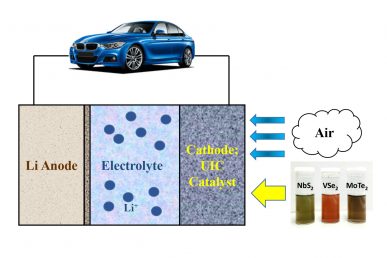Lithium-air batteries are seen as one of the most promising technologies for future energy storage applications. Capable in the theory of storing 10 times more energy than lithium ion batteries and much lower in weight, they are still in development, with their stability and efficiency still not matching expectations. Battery researchers are trying to find catalysts that can increase the rate of the chemical reactions inside the battery, which increases their ability to hold and discharge energy.

Engineers at the University of Illinois at Chicago (UIC) are working on two-dimensional compounds of transition metals – the elements that occupy the central block of the periodic table, which tend to have a large number of electrons per atom that are capable of becoming involved with bonding and electrical activity – with non-metals.
In the journal Advanced Materials, Amin Salehi-Khojin and colleagues from UIC’s College of Engineering describe how a type of compound called transition metal dichalcogenides (TMDCs) enabled lithium-air batteries to hold 10 times more energy than batteries using traditional catalysts. Chalcogenides are compounds incorporating elements of group 16 in the periodic table, including oxygen, sulphur, selenium and tellurium.
Lithium-air batteries use an anode made of pure lithium with external ambient air as the cathode, typically with an aqueous electrolyte. The catalyst is generally dissolved in the electrolyte, and gold and platinum are used conventionally. TMDCs, especially those with two-dimensional shapes, have very high electronic conductivity and fast electron transfer, and according to Salehi-Khojin are bi-functional: that is, they are active both in charging and discharging the battery.
The Chicago team, collaborating with other engineers at Purdue University, Washington University in St Louis and materials scientists at the Argonne National Laboratory, used a battery with an ionic-liquid electrolyte based on dimethyl sulphoxide (DMSO), which is commonly used as a solvent that can dissolve materials containing either charged and uncharged components.
"The 2D TDMCs and the ionic liquid electrolyte that we used acts as a co-catalyst system that helps the electrons transfer faster, leading to faster charges and more efficient storage and discharge of energy," Salehi-Khojin said.
Salehi-Khojin's team synthesised 15 TMDCs including vanadium ditellurate and diselenate and molybdenum and niobium disulphides, and investigated their activity in an electrochemical system mimicking a lithium-air battery.
"In their 2D form, these TMDCs have much better electronic properties and greater reactive surface area to participate in electrochemical reactions within a battery while their structure remains stable," said Leily Majidi, a graduate student in the UIC College of Engineering and first author of the paper. "Reaction rates are much higher with these materials compared to conventional catalysts."
Salehi-Khojin believes that these technologies could become very useful. "We are going to need very high-energy density batteries to power new advanced technologies that are incorporated into phones, laptops and especially electric vehicles," he said. "Currently, electric vehicles average about 100 miles per charge, but with the incorporation of 2D catalysts into lithium-air batteries, we could provide closer to 400 to 500 miles per charge, which would be a real game-changer. These new materials represent a new avenue that can take batteries to the next level, we just need to develop ways to produce and tune them more efficiently and in larger scales.”




Poll: Should the UK’s railways be renationalised?
I think that a network inclusive of the vehicles on it would make sense. However it remains to be seen if there is any plan for it to be for the...